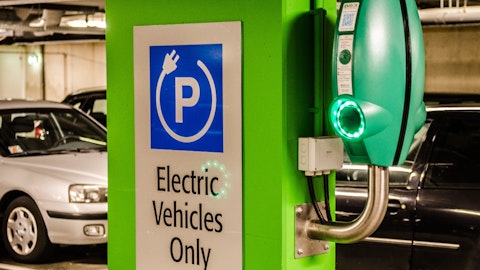Giordano Sordoni: And Mike, this is — sorry to interrupt here. This is Gio. The only thing I’d add to that is with this new model, the 2023 version of the step van, we’re also offering a 200-mile range version of the van and that’s gotten some customers really excited. We diversified the customer mix away from just parcel delivery folks who are typically only looking for 100 miles. The folks in other industries like uniform services that might be interested in heavier duty step van or longer ranges that might require more kilowatt-hours on board, and that’s something this new version of step van enables us to do and that’s something we’re really excited about.
Michael Ward: Thank you. And as you look at the production ramp, you had a sharp fall off there in the fourth quarter. And was that an additional supply issue? Or I think you mentioned in the release that it had somewhat to do with switching over production 2023 version? And so is that the — are those the reasons — maybe it’s both as we accelerate production in 2023 and it sounds like you’re looking at a similar level of deliveries in Q1 and Q2 that we saw in the fourth quarter. What are the things limiting that delivery? Because it sounds like you’re going to have a substantial backlog as you exit 2023 and — so there’s always a risk that customers are going to pull away. So, I’m just wondering what you’re going to do to accelerate productions, accelerate deliveries?
Dakota Semler: Yes, happy to address that, Mike. So, I would say one thing that is common across the entire last-mile logistics industry with Q4 is that it is the peak season in the year. So, some of our customers like FedEx Ground, they’ll go for moving 10 million packages the week before Thanksgiving to 20 million packages the following week. And so with a such an uptick in their operations, it becomes difficult to really do anything else in the business like onboarding new vehicles, training drivers on those new vehicles, they really are focused on getting packages delivered to customers. So, when we look at that, really Q4 is the first six to seven weeks or six to eight weeks of the quarter where we can make deliveries to customers.
After that, it becomes incredibly busy to try and get vehicles delivered to those customers. Along with all of the holiday days, which folks are either traveling or out of the office. So, it makes it difficult to get the same number of vehicles delivered. So, that’s one seasonal factor that always hits during Q4. And by having a diverse — a more diverse customer mix, we actually are able to mitigate that. Some customers like uniform rental or mobile fleet maintenance company, they aren’t going to see that same seasonal peak in Q4. And so we try to slot body builds and vehicle builds for those customers into that that vacancy. It really gives us a — it will give us a little bit of a smoother ramp, but we do anticipate that the seasonal trend will always continue.
The second factor I’d talk about is charging infrastructure. The same reason it’s difficult to deliver vehicles in Q4, we also see similar obstacles in getting charging infrastructure delivered. So, offices are shut down for permit approvals, for utility interconnect studies, and ultimately, for construction. People are just working less through that quarter and so when we talk about commissioning and turning on charging infrastructure for our customers, we generally see less there. So, that was one of the obstacles we face and there’s a little bit of a lag time that goes into Q1 on that seasonal impact. So, that’s where we see it in Q1. Ultimately, the backlog was — is really growing through those quarters. We’re continuing to make sales and seeing sales growth through Q4 and Q1, but we aren’t seeing many cancellations.
Folks still need to transition to zero emissions vehicles because of the regulatory environment and also they’re seeing the incentives of operating a zero emission fleet and how it’s reducing their overall maintenance costs and their overall energy costs.




